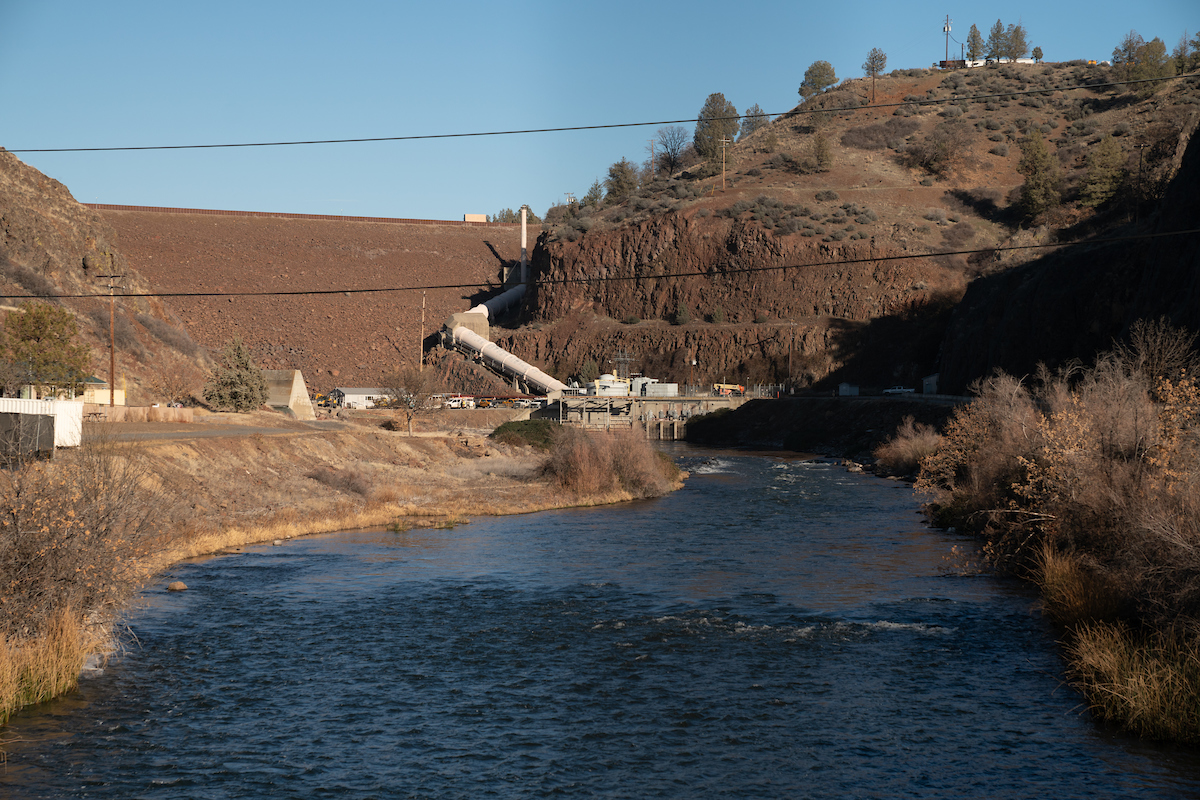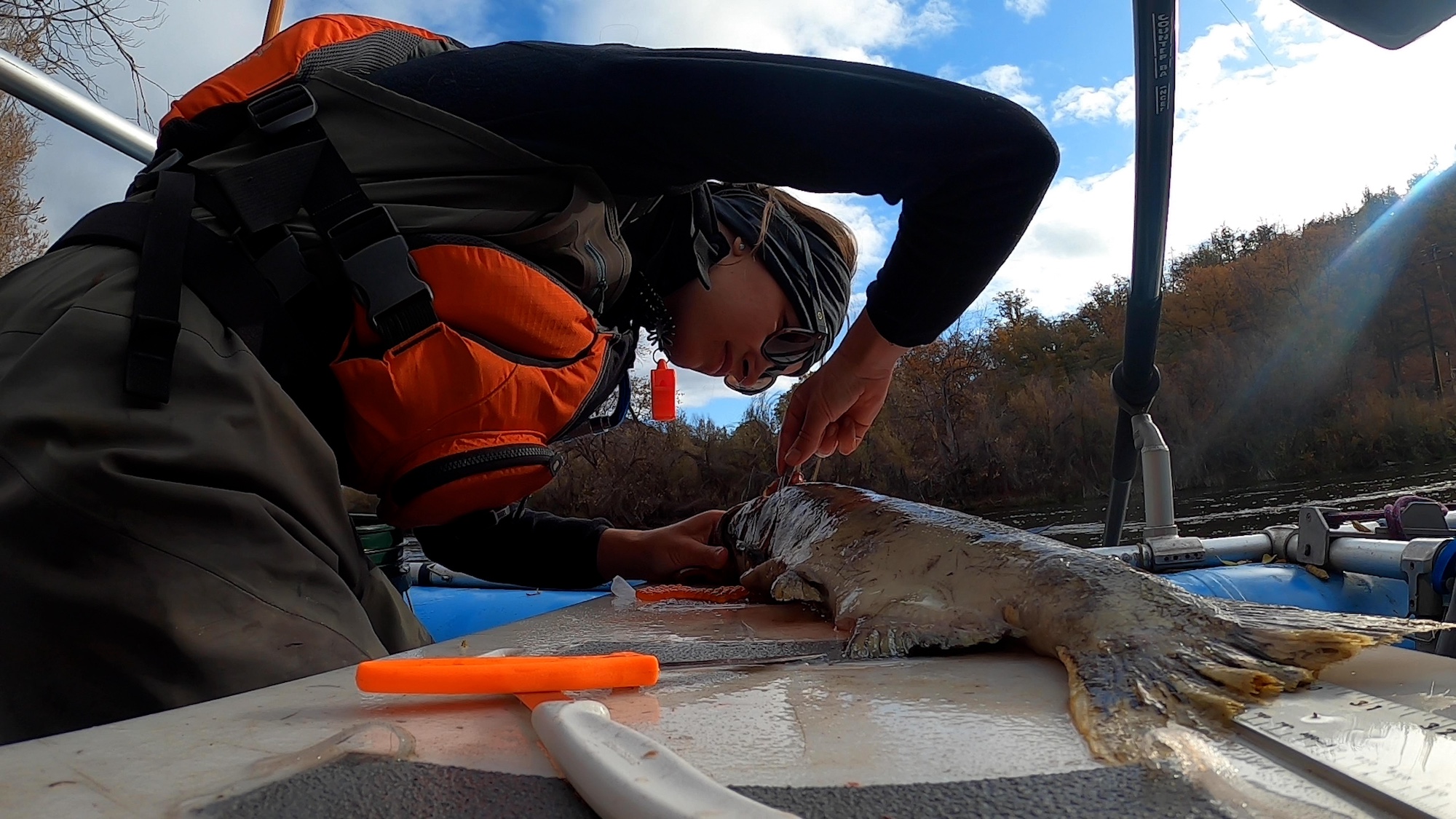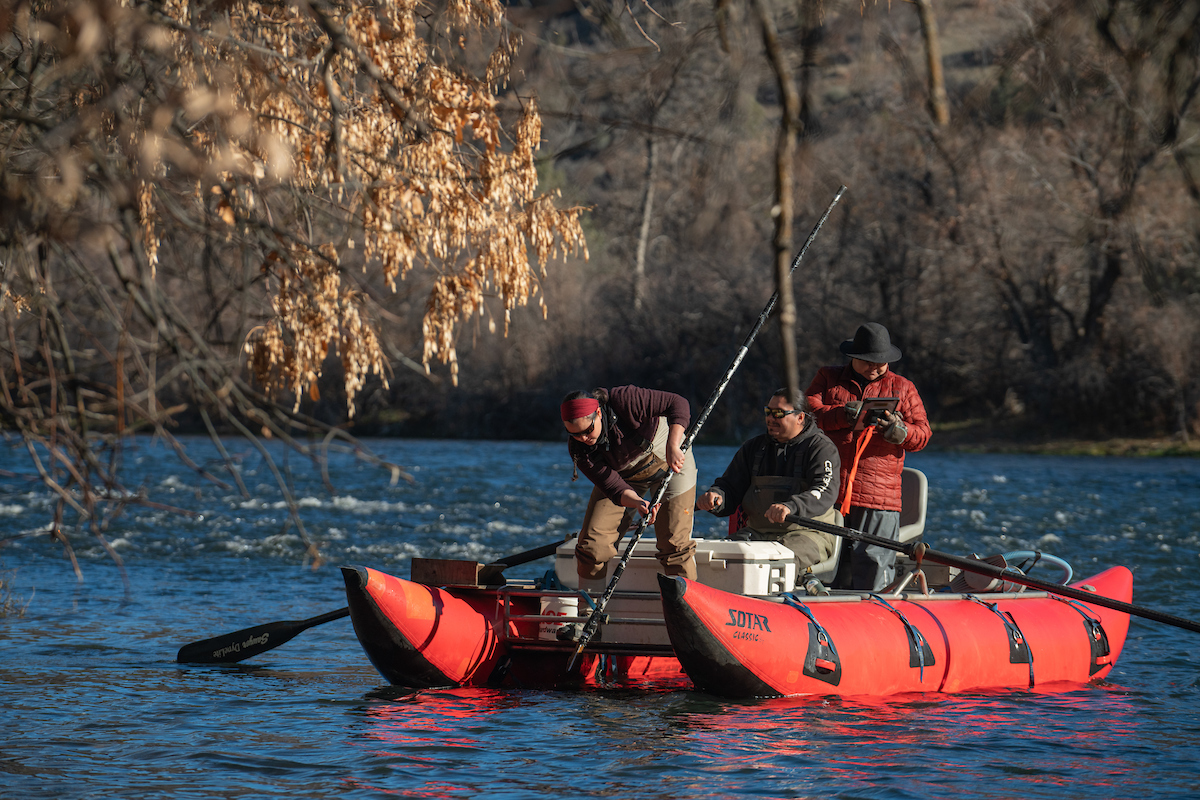
That Dam Removal Project
The world’s largest dam removal project is underway along the 250-mile Klamath River in California and Oregon. By the end of 2024, four of the river’s six dams will be demolished. UC Davis scientists are studying whether it will help salmon populations rebound. The fishes’ ear bones could hold clues to their future. In this episode of Unfold, host Amy Quinton discusses the topic with co-host Kat Kerlin, who has written a multimedia feature story about whether restoring the river to its natural state will also restore decimated salmon populations.
In this episode:
Rob Lusardi, aquatic ecologist, UC Davis Center for Watershed Sciences
Beth Rose Middleton Manning, professor, Department of Native American Studies
Barry McCovey, director of the Yurok Tribal Fisheries Department
Learn more about UC Davis research on the Klamath Dam Removal in the multimedia feature story, written by Kat Kerlin, "The Salmon Diaries: Life Before and After Klamath Dam Removal."


Transcript
Transcribed by AI. May contain errors.
Kat Kerlin
Hey Amy.
Amy Quinton
Hey Kat. Welcome back to Unfold.
Kat Kerlin
Thanks, Amy.
Amy Quinton
This is a special bonus episode of Unfold. We'll have a new episode out next month. But we're here to discuss a very important environmental story that Kat has been working on. As I understand it, we might soon witness environmental healing on a major scale.
Kat Kerlin
Yeah, well, let's hope so. We're talking about the world's largest dam removal project in history. It's along the Klamath River. After more than a century, four of the rivers six dams will be down by the end of this year.
Amy Quinton
And for those unfamiliar with its geography, the Klamath River runs more than 250 miles from Southern Oregon all the way to the Pacific Ocean in Northern California. And these dams were originally built, as I understand it for hydropower.
Kat Kerlin
That's right. Historically, the Klamath was the third largest salmon producing river on the West Coast. Salmon, as you may know, are born in rivers head out to sea, and then returned two rivers at the end of their lives to spawn the dams on the Klamath, which are like 33 to 172 feet high blocked fish from accessing more than 400 miles of spawning habitat. I mean, think about that for a second. Amy, imagine you leave home, and then you come back to a concrete wall, locking you out from everything that made you you.
Amy Quinton
That's quite an eviction, I mean, 400 miles of spawning habitat. That is incredible.
Kat Kerlin
Yeah. Especially when you realize that it's that habitat that helps all of your ancestors persist and stay resilient to all sorts of changes for millions of years.
Amy Quinton
And salmon need cold water to survive and spawn. Water released from dams is often too warm for them to survive. Salmon populations plummeted as a result of these dams and so did water quality. So what happens when all four dams come down? Will salmon populations return?
Kat Kerlin
That is the big dam question that UC Davis scientists and a team of others are hoping to answer.
Amy Quinton
Kat, I know you've written about this and a new multimedia feature story called, "The Salmon Diaries: Life Before and After the Klamath Dam Removal." So tell me a little bit more about this.
Kat Kerlin
Well, first, the dam removal isn't just about restoring salmon or a river. It's also about righting a historic wrong. These dams were built on the ancestral lands of the Yurok, Hoopa and Karuk tribes and downstream of the Klamath tribes of Oregon. I talked with Barry McCovey, who was director of the Yurok tribal fisheries program. When
Barry McCovey
When the dams went in, the tribal people in the Klamath Basin weren't consulted. And I think that was offensive. And people were uncomfortable with that, and have been for over 100 years. And there was always an effort and always in the back of our minds. We knew that we needed to get the dams out, we knew that they were causing, you know, major issues and we knew that you can't just go and break an ecosystem in half.
Kat Kerlin
The lack of consultation is common throughout the history of U.S. dam construction. UC Davis Native American studies professor Beth Rose Middleton Manning explains.
Beth Rose Middleton Manning
Almost every river where there's a dam, there's a history of displacement, disruption, and putting in that infrastructure without the consent of the communities and nations whose homeland that is.
Kat Kerlin
You can't understate the importance of salmon and this river to tribal cultural identity. I heard from several Native people along the Klamath that without salmon, there is no tribe. The connection is that absolute.
Amy Quinton
So Kat, what finally led up to the agreement that the dams should come down?
Kat Kerlin
Well, it didn't happen for a long time. You got to remember the first dam was built in 1908. And many people were against that from day one. But there was this massive fish kill in 2002. And it made "Un-dam the Klamath," this rallying cry led by the tribes and picked up by all sorts of voices. That's when momentum really began to build. But it took another 20 years for FERC, or the Federal Energy Regulatory Commission, to approve the decommissioning project in 2022. First dam came down last year. The last dam is expected to come down this fall, just in time for the return of the Chinook salmon.
Amy Quinton
Wow, that's a really long time that those dams have been up. So how is UC Davis involved in this story?
Kat Kerlin
Well, we're very fishy people. For the past four years, UC Davis freshwater ecologist Rob Lusardi and his team have been collecting data along the river, things like temperature, water chemistry, and aquatic insects. All of these offer clues to understanding a changing river. This idea was to collect the data before the dams came down, and then compare them to after the dams' removal. Most fascinating part of all this to me, is what he's been doing with the fishes' otoliths.
Amy Quinton
Otoliths. I remember we talked about those in Season 2 of Unfold, remember?
Kat Kerlin
I do.
Amy Quinton
Nature Tells Its Story: Fish Eyes and Ears. You can find it on our website.
Kat Kerlin
That's right. Otoliths are the ear bones of fish. The Yurok tribe and the US Fish and Wildlife Service extract these ear bones from the salmon they collect when they go out on fish carcass surveys, then they send the odotoliths to Rob's lab at UC Davis. Here's how Rob explains it.
Rob Lusardi
Otoliths are like these mini little data loggers. And we can use the microchemistry of those otoliths tell us the habitats that those fish have used throughout the basin and get a really nice idea for what tributaries they're using how long they are in the main stem when they hit the ocean, all of that.
Amy Quinton
Okay, there's a lot of science here. So explain this to me a bit more. How does it work?
Kat Kerlin
Sure. This is actually my favorite part. It's full of "Who woulda thunk it" science. Are you ready?
Amy Quinton
Yep.
Kat Kerlin
Okay. There's a naturally occurring chemical called strontium found in rocks, soil and water. Each stream of the Klamath carries its own unique strontium signal. Like its own flavor right. Rob's lab has been sampling these streams to basically create a map of strontium signals throughout the watershed.
Amy Quinton
Okay, otoliths. Get back to those. What does this have to do with fish ears?
Kat Kerlin
Everything. As a salmon swims over the rocks and streams of its life. It picks up and stores strontium signals in their otoliths, their ears. It leaves us telltale record of where that fish lived throughout its life.
Kat Kerlin
That's really amazing.
Kat Kerlin
Right? Who would have thunk it? The other thing that amazes me is how they figured this out to begin with. I mean, at some point, scientists had to figure out that through grinding, polishing, laser blasting this otolith, they could get at that record, which looks oddly just like the cross section of a tree, tree rings and all.
Amy Quinton
Oh that's interesting.
Kat Kerlin
And by matching that to Rob's Klamath Basin strontium map, they can know exactly when and where that fish spent its life along the Klamath.
Amy Quinton
Kinda like reading a salmon's diary?
Kat Kerlin
Yeah, sounds shady when you say it that way. But this kind of science has never been done before for a dam removal project. And it's what's going to help answer those big dam questions we talked about.
Amy Quinton
Okay, so you obviously took a trip up to the Klamath to see all of this work in action. What did you experience? What was it like?
Kat Kerlin
Yeah, I did. I love it up there. We were there in late November 2023. First, we went to the mouth of the Klamath in foggy north coast, California, on the Yurok's ancestral land. Then we went as far upriver as salmon could reach for the last 100 years to Iron Gate Dam near Yreka. It was 32 degrees and the coldest river put in that we have ever experienced.
Amy Quinton
Yeah, imagine in November. It's not toasty warm.
Kat Kerlin
No, there was literally ice on the tree ranches. Okay, we got to tag along with the Yurok and the U.S. Fish and Wildlife Service on their last salmon carcass survey of the fall season, just to see like how they collect fish and these otoliths. At the time, there were demolition crews that were prepping Iron Gate for removal. So in the background, there were these construction trucks beeping and scraping. It felt like this really momentous time to be on the river.
Amy Quinton
After the dams come down, does Rob have an idea of what changes we should expect to see? I mean, do we think salmon populations will bounce back quickly?
Kat Kerlin
Well, Rob, and most people I spoke with expect water quality to improve pretty quickly. Salmon, we're going to take a few more years to figure out most do expect the salmon will return and their populations will increase. But Rob's not just interested in the number of salmon. He wants to bring back their life history diversity.
Amy Quinton
What does that mean, biodiversity?
Kat Kerlin
Not quite. It's the idea that before the dams and I'm talking for millions of years, salmon had this diversity of life experiences. They used a variety of habitats, they migrated at different times. If something happened, like say a landslide or an earthquake, there was enough resilience in their population to weather a few bumps and losses along the way. Dams change all that. Removing them and restoring the river can begin to right that wrong as well. Here's Rob Lusardi again.
Rob Lusardi
A step like this removing four large dams on the Klamath River is obviously important from a cultural and spiritual and economic perspective. But it's also really important for the ecology, and really important for salmon themselves. Of all the things that we could do for salmon, promoting access to headwater habitat to cold water to pristine waters, in some cases, like the headwaters above upper Klamath Lake is basically the best thing we could do at this point.
Amy Quinton
So Kat you spent a lot of time on this story? What do you think people should learn from the Klamath dam removal?
Kat Kerlin
One final thought is that this is not just a story about the Klamath. Across the world, there are 1000s of what some people call deadbeat dams. These are dams that have outlived their purpose, and just south of the Klamath, even there are plans underway right now to remove dams on the Eel River. They could be out as soon as 2028. Yeah, so there are a lot of eyes looking to the Klamath for lessons and answers and for the first time, our science is helping to provide a piece of that with this level of accuracy that no dam removal has had before.
Amy Quinton
Cool. So you can read Kat's story, "The Salmon Diaries, Life Before and After the Klamath Dam Removal," at ucdavis.edu/climate.
Kat Kerlin
There you'll also find a great video on the Klamath dam removal by multimedia specialist Alysha Beck.
Amy Quinton
It's very good. Check it out. And as always find a link to the story and all the Unfold episodes at ucdavis.edu/unfold. I'm Amy Quinton.
Amy Quinton
I'm Kat Kerlin. Thanks for listening.
Andy Fell
Unfold is a production of UC Davis. Original music for Unfold comes from Damien Verrett and Curtis Jerome Haynes. Additional music comes from Blue Dot sessions.